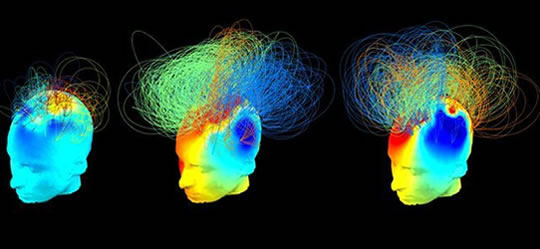New analysis of brain waves reveals consciousness in patients who appeared to be vegetative.
Scientist have used a new test on patients in a persistent vegetative state to show some have active brain networks that could support consciousness.
People with severe brain injuries — resulting from, say, car crashes or heart attacks — can appear to be unaware of the world around them, despite looking as though they are awake.
Patients in this state can look around the room, but do not react to anything said to them and none of their movements seem purposeful.
Nevertheless, the new test suggests some of these patients may have enough brain activity to support consciousness.
The researchers also asked some patients to try and imagine playing tennis, while an fMRI scanner was used to try and locate activity in the motor cortex.
In the image above, the middle person is imagining playing tennis, despite being in a persistent vegetative state.
In comparison, the right hand person is a healthy adult and the left-hand person is also in a persistent vegetative state, but showing little brain activity.
Dr Srivas Chennu, the study’s first author, said:
“Understanding how consciousness arises from the interactions between networks of brain regions is an elusive but fascinating scientific question.
But for patients diagnosed as vegetative and minimally conscious, and their families, this is far more than just an academic question — it takes on a very real significance.”
In the study, the brain activity of 32 patients who had been diagnosed as vegetative and minimally conscious was analysed (Chennu et al., 2014).
These patients were compared to a group of healthy adults.
The study used EEG (measuring the electrical activity of the brain) along with complex mathematics to examine networks of brain activity.
While many patients showed little activity, some had well-preserved networks in their brains that were similar to healthy adults.
Dr Tristan Bekinschtein, another of the study’s authors, said:
“Although there are limitations to how predictive our test would be used in isolation, combined with other tests it could help in the clinical assessment of patients.
If a patient’s ‘awareness’ networks are intact, then we know that they are likely to be aware of what is going on around them.
But unfortunately, they also suggest that vegetative patients with severely impaired networks at rest are unlikely to show any signs of consciousness.”
Image credit: Srivas Chennu

